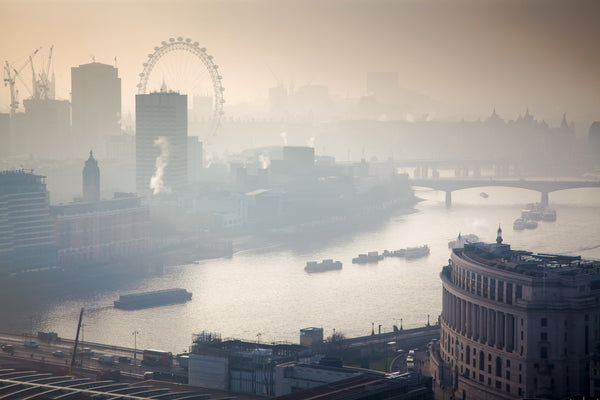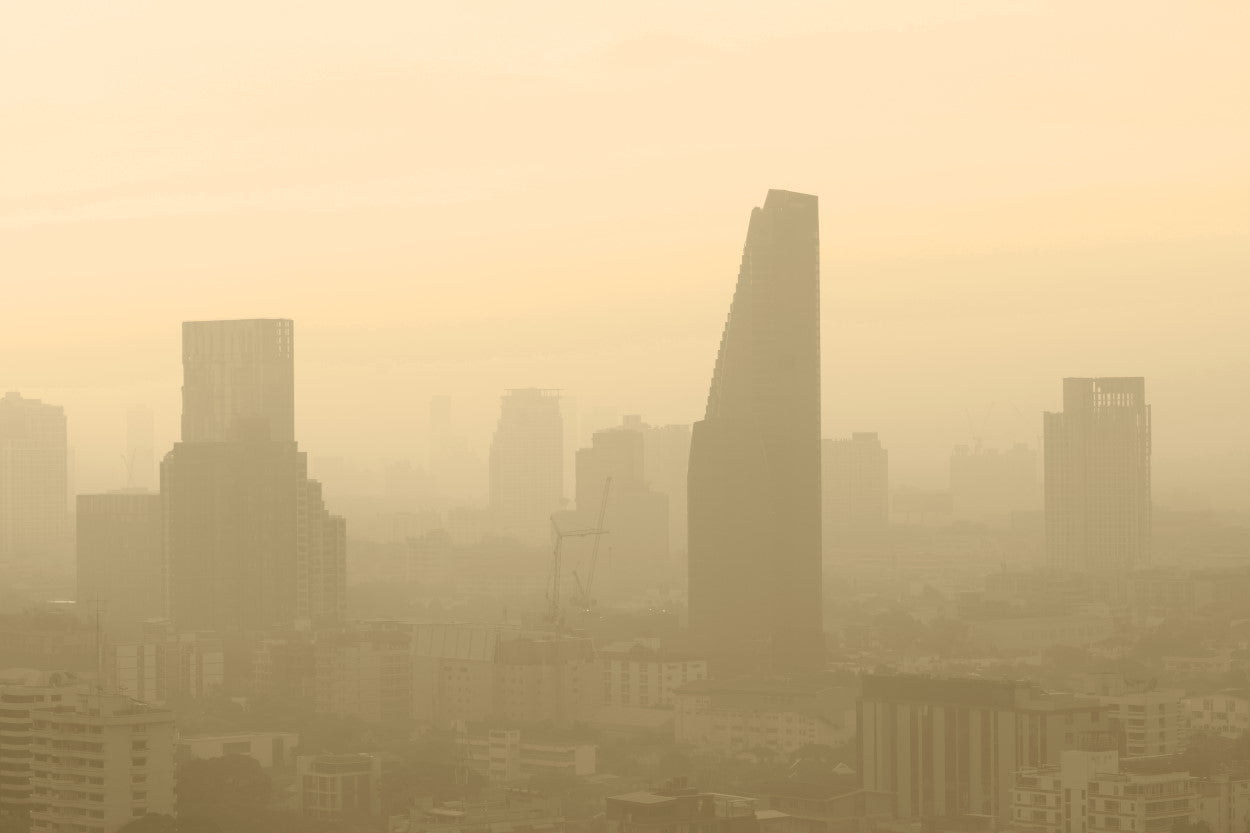In the fall of 2020, downtown Los Angeles suffered the worst smog it had seen in almost 30 years when ozone pollution spiked to 185 parts per billion. For many, it was a bleak reminder of the pervasive yellow-brown haze that used to hover over the city. Thanks to its geography and notoriously heavy traffic, LA has a long history of severe air pollution (so much so that during much of the 20th century, the city itself became synonymous with “smog”). It was even ranked the most polluted basin in the country when the Clean Air Act was introduced in 1970. Thankfully, since then, smog—and its resulting ozone pollution—has decreased significantly in the area.
LA certainly isn’t the only city that experiences severe smog and ozone pollution. It’s a hazard in many high-population, high-traffic areas, despite ongoing efforts to increase outdoor air quality. Here, we’ll go into what causes smog, the health effects of smog, and what you can do to protect yourself.
What is smog?
The term “smog” was coined in the early 1900s to describe the mix of smoke and fog caused by burning coal in industrial areas. Since then, the phenomenon has only become more common. Smog is a visible type of air pollution that contains a mixture of pollutants, including particulate matter (PM), ground-level ozone (O3), carbon monoxide (CO), volatile organic compounds (VOCs), nitrogen oxides (NOx), and sulfur dioxide (SO2). It often appears as a brownish-yellow mist.
When people first started noticing smog around industrial areas, it was caused by burning large amounts of high-sulfur coal. That kind of smog is often referred to as London-type smog. Today, most smog is produced by the reaction of nitrogen oxides, VOCs, and sunlight. This is called photochemical smog. This is one of the types of smog that forms after it gets into the atmosphere.
Photochemical smog
When fossil fuels are burned to power vehicles, power plants, and factories, they release nitrogen oxides, VOCs, and other pollutants into the air. Then, as sunlight hits the nitrogen oxides and VOCs, it causes a chemical reaction that creates another pollutant: ozone. As long as there’s sunlight, the chemicals in photochemical smog can continue reacting with each other, creating more ozone, particulate matter, and VOCs. Photochemical smog components include particles that have picked up free radicals, aldehydes, peroxyacyl nitrates, and other reactive and unhealthy substances.
Photochemical smog can be found clouding many major cities across the globe, thanks to increased traffic and industrial emissions in high-population areas. Smog also tends to worsen on warm summer days with plenty of sunlight to fuel the chemical reactions. During inversion layer events (when warm air lingers over an area and traps the layer of air near the surface), smog can stay in the air for days or more, getting worse as more and more emissions react with the sunlight. And, as photochemical smog gets more severe, so does the danger it poses to human health.

Why is smog unhealthy?
Photochemical smog is dangerous because of the mix of pollutants it holds, many of which are known to have adverse health effects. Most symptoms of smog exposure are short-term, meaning they should go away within a few hours or days of exposure. However, repeated damage from smog exposure may cause lasting health effects, especially in children, adults who are active outdoors, and individuals with respiratory diseases. The potential damage from smog inhalation increases with the length and severity of the exposure.
Particulate matter in photochemical smog
Particulate matter refers to tiny solid particles and liquid droplets floating in the air. These contribute to the haze and reduced visibility associated with smog. Some PM, such as dust, can be seen by the naked eye. Other PM, called fine particulate matter, is microscopic. Fine PM (less than 2.5 micrometers in diameter) present the greatest health risk because they are small enough to be inhaled and enter the lungs. Some particles may even go further and enter the bloodstream.
The smaller a particle is, the more dangerous it is. On days with photochemical smog, outdoor fine PM concentrations are often at their highest, posing a significant threat to public health. Exposure to particulate matter from smog may cause:
- Coughing, difficulty breathing, and irritation of the airways;
- Respiratory illness and infections;
- Aggravated asthma symptoms.
More severe problems linked to particle pollution include decreased lung function, irregular heartbeat, nonfatal heart attacks, and premature death in people with lung or heart disease.
Ground-level ozone in photochemical smog
Aside from PM, ground-level ozone is the top health threat associated with smog exposure. Though ozone in Earth’s upper atmosphere is beneficial, shielding the planet from harmful ultraviolet (UV) rays, ground-level ozone is a different story. Ozone is one of the main components of photochemical smog, and it’s associated with many health problems, including:
- Coughing, throat irritation, and chest tightness;
- Reduced lung function and difficulty breathing;
- Aggravated asthma and allergy symptoms;
- Inflammation and damage to lung lining;
- Aggravated chronic lung diseases, including bronchitis and emphysema.
Other pollutants in photochemical smog
Though PM and ozone are the main concerns associated with smog, they aren’t the only photochemical smog components that can cause health effects:
- Nitrogen oxides can cause coughing, shortness of breath, lung irritation, and decreased resistance to infection.
- Sulfur dioxide may cause shortness of breath, eye irritation, and reduced lung function.
- Carbon monoxide is poisonous and can impair your blood’s ability to carry oxygen to your organs. In high concentrations, it can be fatal.
- Volatile organic compounds are a diverse group of carbon-based chemicals, many of which can have both short- and long-term health effects. Some VOCs are also known or suspected carcinogens.
How to protect yourself from smog
Smog can happen anywhere, but it’s especially prevalent in crowded, high-traffic areas. Living, working, or going to school near a busy road can increase your risk of many short- and long-term health effects, such as asthma, decreased lung function, impaired lung development in children, and cardiovascular problems in adults.
When photochemical smog clouds the air outside, it can seem like there isn’t much you can do to avoid exposure. Fortunately, that’s not completely true. To decrease your exposure to smog on poor air quality days, you can:
- Keep your car and home windows closed;
- Avoid busy streets and truck routes during your commute;
- Stay indoors during high-traffic times, such as rush hour;
- Change your car’s cabin air filter regularly.
By using a site like AirNow.gov, you can stay up-to-date on the air quality in your area. Then, you can schedule outdoor plans (especially workouts and other physically demanding activities) on days with good air quality. If you cannot avoid spending time outdoors on smoggy days, try to do so in the early morning or late evening when traffic emissions are usually lower.
Smog and indoor air pollution
On days when smog is bad, staying indoors may not be enough to avoid exposure. Outdoor air can come indoors through gaps or cracks in the door frames, walls, and windows. To minimize the presence of airborne pollutants in your home, you can:
- Use exhaust fans to vent air to the outside;
- Avoid using high-pollution products, such as cleaning chemicals, paints, and air fresheners, on bad air quality days;
- Avoid activities that create PM, such as lighting fires, frying or sautéing foods on the stove, or burning incense or candles;
- Increase ventilation by opening the windows on good air quality days;
- Use an air purifier to trap airborne pollutants.
Reducing your contribution to smog
Smog is a human-made air quality problem, and humans have the power to reduce its presence. You can decrease vehicle emissions and, therefore, reduce your contribution to smog by:
- Choosing to walk, bike, carpool, or take public transportation;
- Combining errands or rescheduling them for days with less smog;
- Avoiding grilling or lighting a fire in the fireplace on bad air quality days;
- Tuning up your car regularly to reduce emissions;
- Switching to electric yard equipment and appliances;
- Avoiding idling your vehicle;
- Putting gas in your car in the evening when it’s cooler (to prevent the gasoline fumes from reacting with the sunlight);
- Conserving electricity by setting your air conditioner at 78 degrees Fahrenheit or higher;
- Voting for local measures aimed at improving outdoor air quality.
Hopefully, one day smog will be known as a relic of the past. For now, you can protect yourself by staying informed about your local air quality, reducing your smog exposure, and trying to lower your air pollution contributions whenever possible.







